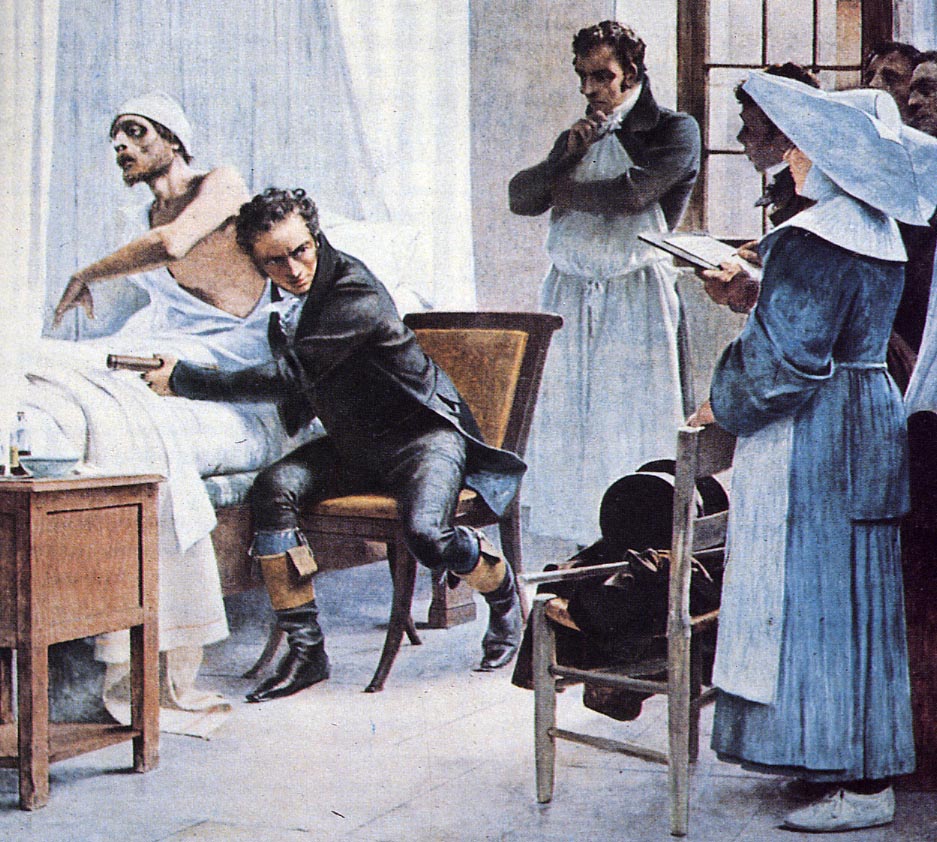- Lung Auscultation – Normal Breath Sounds
- Lung Auscultation – Adventitious Breath Sounds
- Lung Auscultation – Vocal Resonance
History
Auscultation was known to the physicians even in the times of the ancient Egypt. Hippocrates tried to listen to the body sounds by applying the ear directly to the chest trying to detect any accumulation of fluid within it. This immediate auscultation was the only method of auscultation until the discovery of stethoscope in 1816 by René Laennec.
Laennec was a French physician, skilled woodturner and also a flutist. In 1816 when examining young female patient he felt embarrassed to place his ear to her chest. Instead he rolled up 24 sheets of paper and placed one end to her chest and the other one to her ear. To his surprise the sound was conveyed louder and clearer than with immediate auscultation.
His particular sets of skills were useful in developing new instrument for auscultation he called “Le Cylindre”. It was a two part 12 inches long and 1.5 inches thick wooden cylinder for listening of the lungs with another removable cone-shaped plug used for listening of the heart. Finally, unsatisfied with the names given by his colleagues he decided to call it the “stethoscope”. In 1819 he published his famous work A Treatise on the Disease of the Chest.
Clinical Vignette
To be added at later date.
Physical Examination
There are two methods of auscultation – the immediate and mediate auscultation.
Immediate auscultation. In this method the physician is listening to the body wall directly with the unaided ear. However, since the discovery of stethoscope this method was replaced by more accurate, convenient and hygienic mediate auscultation.
Mediate auscultation. It’s the method of auscultation as known today. The physician is listening to the body wall indirectly through the stethoscope which is composed of the bell or membrane, the tubing and the earpieces.
There is no best way of listening to the lungs. Some physicians prefer to listen back to front, top to bottom or vice versa. The key to detailed and correct examination is systematic approach. Any kind.
- Room and patient setup. Room should be quiet and patient sitting up, decently exposed. Female patients should have only front or back of the chest exposed at once. If the patient is not able to sit up, roll the patient to each side to examine the back.
- Warming up. Warm up the cold stethoscope by rubbing the membrane. Even if it’s not cold it’s a nice gesture of special care.
- Breathing. Ask the patient to breathe deeply through the open mouth. When listening to the back, ask the patient to cross arms over the chest to evert the shoulder blades.
- Stethoscope placement. Listen to the front or back of the chest first, from apex to base or vice versa based on your preferences and clinical judgement. The key is to listen to the all of the chest. At each place listen to at least one complete breath cycle.
- Compare. Listen to and compare identical places on each sides. Focus on breath sounds, their quality, intensity and pitch. Mind the length of the inspiration and expiration and continuity (or gap).
Interpretation
Breath (lung) sounds are noises produced by the structures of the lungs while breathing. There are two types of breath sounds – normal lung sounds (formerly known as vesicular) and normal tracheal sounds. They are distinguished by their timing, intensity and pitch. Additionally, there is bronchial breathing which is similar to tracheal sound except it’s always abnormal.
Normal lung sounds. Formerly known as vesicular breath sounds. As the term implies, they are normal lung sounds heard over the surface of the chest, mostly the posterior part. Normally, they are heard clearly during inspiration but only early in the expiration, thus the inspiration seems longer than expiration. They are soft and low pitched like the sound of leaves rustling in a gentle breeze. The intensity of normal lung sounds is proportional to the flow of the air at the mouth, increased in laboured breathing and decreased in airflow obstruction like COPD.
One of the most common misconception that led to the original name is that normal lung sound is produced by air entering the alveoli. Studies have shown this is simply not true and that inspiratory component is most likely generated within the peripheral airways (lobar and segmental) and the expiratory component is generated more centrally. Therefore the recommendations are to replace the term “vesicular” with “normal”.
Normal tracheal sounds. As the term implies, they are normally heard over trachea. Unlike normal lung sounds they are of harsher quality and higher pitched sounding like forced blowing of the air through the tube. They originate in trachea and proximal airways and therefore have prominent expiratory component with audible gap between the inspiration and expiration.
Bronchial breathing. This refers to abnormal sounds. Pathologically they can sometimes be heard in pneumonia or pleural effusion.
| Normal lung sounds | Normal tracheal sounds, Bronchial breathing | |
| Timing | Inspiratory | Expiratory |
| Intensity | Soft | Harsh |
| Pitch | Low | High |
| Location normally heard | Posterior chest | Trachea |
| Associated pathology | None | Pneumonia, pleural effusion |
Based on McGee, S. R. (2018).
Breath Sound Score
Breath sound intensity score is a grading system developed by Pardee for quantifying the intensity of breath sounds, assessing the probability of chronic airflow obstruction.
More about breath sound score in the upcoming article about diagnosing chronic airflow obstruction.
Clinical Significance
To be added at later date.
Caveats and Errors
Breathing through the nose. Common error of the examiner is to listen to the lungs while patient is breathing through the nose which could diminish the intensity of the breath sounds. Instruct the patient to breathe deeply through the open mouth.
Listening through clothing. To accurately assess the lung sounds physician should never listen to the chest through the clothing. The patient should be exposed just enough to protect his or her modesty while having access to the bare chest.
Sitting up straight. Patients use to sit up straight when listening to the back of the chest. This retracts the shoulder blades covering the lungs. Ask them to cross their arms over the chest to evert the shoulder blades.
References
Chi, J., Artandi, M., Kugler, J., Ozdalga, E., Hosamani, P., Koehler, E., … Verghese, A. (2016). The Five-Minute Moment. The American Journal of Medicine, 129(8), 792–795. https://doi.org/10.1016/j.amjmed.2016.02.020
Rackow, E. (n.d.). The Monoaural Stethoscope. Retrieved from http://www.antiquemed.com/monaural_stethoscope.htm
McGee, S. R. (2018). Evidence-based physical diagnosis (4th edition). Philadelphia, PA: Elsevier.
Bohadana, A., Izbicki, G., & Kraman, S. S. (2014). Fundamentals of Lung Auscultation. New England Journal of Medicine, 370(8), 744–751. https://doi.org/10.1056/NEJMra1302901
Pasterkamp, H., Brand, P. L. P., Everard, M., Garcia-Marcos, L., Melbye, H., & Priftis, K. N. (2016). Towards the standardisation of lung sound nomenclature. European Respiratory Journal, 47(3), 724–732. https://doi.org/10.1183/13993003.01132-2015

